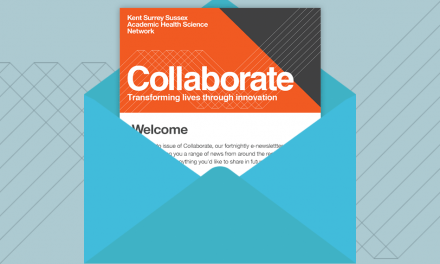Becky Clack, Innovation Manager, KSS AHSN blogs about the areas of greatest unmet needs in cancer care and explores partnership opportunities for innovators.
Opportunities to innovate in cancer care
For me, the biggest opportunities for innovators in cancer care are across three key areas, 1) supporting a life with cancer, 2) earlier diagnosis of rare cancers and 3) addressing inequalities in cancer care.
Living with cancer
More people are now living longer with, or after cancer. We need to understand if these individuals are living the best possible life they can with their condition. I’d like to see more innovations enable people to live well with cancer, through diagnosis, treatment and beyond.
One example is a UK trial using a blood biomarker test to determine if people with bowel cancer need further treatment after surgery. [1] Usually, bowel cancer patients receive surgery, followed by chemotherapy, which can be aggressive with long recovery times. The biomarker is used to see if any cancer remains after surgery. When no further cancer is detected, the patient avoids chemotherapy and focuses on recovery.
There are many exciting developments, including apps and technologies addressing the financial, psychological, and social burdens of managing cancer too.
Early detection of rare cancers
Detection of rarer and aggressive cancers still lags behind. For example, pancreatic and brain cancer can have poorer outcomes than other cancers because they are hard to catch early, and treatment can be more complex.[2]
Innovations are already supporting early diagnosis of common cancers, e.g., lung cancer. There’s a national lung health check programme using case findings to identify individuals with a higher risk of developing lung cancer. Patients who match the set criteria are invited for further tests. Targeted approaches may result in lung cancer being detected and treated earlier, resulting in better outcomes.
Targeted screening programmes are being explored for detecting rarer, aggressive cancers. One approach showing promise are multi-cancer early detection tests (MCEDs), which capture a special signal in the blood which is a marker for cancer. Research and innovation in both the detection and treatment space can make a life-changing difference to patients living with rarer cancers.
Cancer inequalities
Existing healthcare inequalities in cancer were exacerbated by COVID-19, like other areas of healthcare. Often when we think about inequalities, we focus on equity of access to diagnosis or treatment. However, we should also explore social determinants that may lead to cancer.
For instance, a Cancer Research study found people living in deprived areas are 2.5 times more likely to smoke than those in least deprived and find it harder to quit.[3] Part of our commitment to addressing inequalities must include innovative solutions to reduce these risk factors, e.g., smoking in our most deprived communities too.
Innovators can proactively consider how their product/solution positively or negatively contributes to health inequalities too. For example, if a product inadvertently has a negative impact on health inequalities, what can you do to counteract that?
Important factors for engaging with health and social care leaders
Understanding the treatment journey for cancer is critical. For patients, this is often a complex journey through a complex system. Innovators should understand who and what is involved at each stage of the respective pathway and the time targets clinicians have to meet.
The Academic Health Science Network (AHSN) is well placed to support innovators in the cancer space. We have 15 regional organisations in England, including my team in Kent, Surrey and Sussex. We help innovators to understand and navigate the complex cancer landscape and to engage with clinical teams, patients, and decision makers.
The National Cancer Team and Cancer Alliances in England are important organisations to be aware of too. The NHS National Cancer team sets the cancer strategy for the whole country. There are 21 Cancer Alliances in England, responsible locally and regionally to work with other stakeholders to deliver cancer transformation. Alongside national themes such as increasing earlier diagnosis, each Cancer Alliance focuses on improving specific inequalities within their location. The AHSN Network has strong relationships with local Cancer Alliances and can help regional innovators to link in with local teams and priorities.
Standing out
It’s a tricky environment. The NHS is under more pressure than ever before, so breaking through the noise is hard.
You need to be clear on your offer and how it differs to other approaches. We see too many innovations without a clear value proposition. You need to know how your innovation can change and improve pathways to stand apart.
Taking time to evidence your product benefits clearly is also important. Real-world evidence can demonstrate how your idea can change things for employees and patients.
We’re always open to ideas that have worked in other pathways that could be applied to cancer too.
Exciting innovations in cancer
I’m lucky to have worked with so many amazing cancer innovators, all with creative solutions to real problems.
I find cancer biomarkers a progressive area. We’ve recently worked with PinPoint Data Science – a well-developed innovation in the blood biomarkers space. Their solution is an artificial intelligence cancer detection test that allows clinicians to ‘red flag’ high-risk patients. PinPoint previously secured SBRI Healthcare funding to rollout their innovation across areas of England and their CEO was recently announced as an NHS Innovation Accelerator Fellow for 2023.
We’ve also worked with Cyted on Cytosponge – a diagnostic test to simply identify oesophageal conditions, e.g., Barrett’s oesophagus, in 15 minutes. Early detection using this approach may make treatment easier and reduce the impact on patients. Cytosponge is reducing NHS waiting lists too as some patients will not need to go on to have a gastroscopy. A hospital in Kent is part of a national pilot testing use in secondary care, and other sites in the country are testing it in GP practices and diagnostic centres.
Finally, skin cancer innovations can help to reduce current pathway pressures. I’m excited by companies with simple solutions like photography of skin lesions, moles, which are used in community settings. Dermatology consultants review pictures remotely to diagnose cancer. Early data suggests digital approaches may reduce pressure off this pathway in future.
If you have an innovation in the cancer space that you would like to discuss with our team, please contact us.




